16.11.2020

A SpaceX Falcon 9 rocket carrying the company's Crew Dragon spacecraft is launched on NASA’s SpaceX Crew-1 mission to the International Space Station with NASA astronauts Mike Hopkins, Victor Glover, Shannon Walker, and Japan Aerospace Exploration Agency astronaut Soichi Noguchi onboard, Sunday, Nov. 15, 2020, at NASA’s Kennedy Space Center in Florida. NASA’s SpaceX Crew-1 mission is the first crew rotation mission of the SpaceX Crew Dragon spacecraft and Falcon 9 rocket to the International Space Station as part of the agency’s Commercial Crew Program. Hopkins, Glover, Walker, and Noguchi launched at 7:27 p.m. EST from Launch Complex 39A at the Kennedy Space Center to begin a six month mission onboard the orbital outpost.
Credits: NASA/Joel Kowsky
An international crew of astronauts is en route to the International Space Station following a successful launch on the first NASA-certified commercial human spacecraft system in history. NASA’s SpaceX Crew-1 mission lifted off at 7:27 p.m. EST Sunday from Launch Complex 39A at the agency’s Kennedy Space Center in Florida.
The SpaceX Falcon 9 rocket propelled the Crew Dragon spacecraft with NASA astronauts Michael Hopkins, Victor Glover, and Shannon Walker, along with Soichi Noguchi of the Japan Aerospace Exploration Agency (JAXA), into orbit to begin a six-month science mission aboard the space station.
“NASA is delivering on its commitment to the American people and our international partners to provide safe, reliable, and cost-effective missions to the International Space Station using American private industry,” said NASA Administrator Jim Bridenstine. “This is an important mission for NASA, SpaceX and our partners at JAXA, and we look forward to watching this crew arrive at station to carry on our partnership for all of humanity.”
The Crew Dragon spacecraft, named Resilience, will dock autonomously to the forward port of the station’s Harmony module about 11 p.m. Monday, Nov. 16. NASA Television and the agency’s website are providing ongoing live coverage through docking, hatch opening, and the ceremony to welcome the crew aboard the orbiting laboratory.
"I could not be more proud of the work we've done here today,” said Gwynne Shotwell, president and chief operating officer of SpaceX. “Falcon 9 looked great, Dragon was dropped off into a beautiful orbit about 12 minutes into the mission, and we'll get more data as we go.”
The Crew-1 mission is the first of six crewed missions NASA and SpaceX will fly as part of the agency’s Commercial Crew Program. This mission has several firsts, including:
- The first flight of the NASA-certified commercial system designed for crew transportation, which moves the system from development into regular flights;
- The first international crew of four to launch on an American commercial spacecraft;
- The first time the space station’s long duration expedition crew size will increase from six to seven crew members, which will add to the crew time available for research; and
- The first time the Federal Aviation Administration has licensed a human orbital spaceflight launch.
The astronauts named the Crew Dragon spacecraft Resilience, highlighting the dedication teams involved with the mission have displayed and to demonstrate that when we work together, there is no limit to what we can achieve. They named it in honor of their families, colleagues, and fellow citizens.
“Watching this mission launch is a special moment for NASA and our SpaceX team,” said Steve Stich, manager of NASA’s Commercial Crew Program. “We are looking forward to getting this crew to station to continue our important work, and I want to thank the teams for the amazing effort to make the next generation of human space transportation possible.”
During flight, SpaceX commands the spacecraft from its mission control center in Hawthorne, California, and NASA teams monitor space station operations throughout the flight from the Mission Control Center at the agency’s Johnson Space Center in Houston.
Hopkins, Glover, Walker, and Noguchi will join the Expedition 64 crew of Commander Sergey Ryzhikov and Flight Engineer Sergey Kud-Sverchkov, both of the Russian space agency Roscosmos, and Flight Engineer Kate Rubins of NASA.
“It is an honor to have our Japanese astronaut launch on this Crew-1 Dragon as the first astronaut of the International Partner participating in the ISS program,” said Hiroshi Sasaki, JAXA vice president. “We look forward to having him conduct lots of science and demonstrate the technology, for here on Earth and for the future. I would also like to thank NASA and SpaceX for their tremendous effort to make this happen.”
Rubins, Hopkins, Glover, Walker, and Noguchi will participate in a live crew news conference from orbit at 9:55 a.m. Thursday, Nov. 19, on NASA TV and the agency’s website.
Crew-1 Astronauts
Michael Hopkins is commander of the Crew Dragon spacecraft and the Crew-1 mission. Hopkins is responsible for all phases of flight, from launch to re-entry. He also will serve as an Expedition 64 flight engineer aboard the station. Selected as a NASA astronaut in 2009, Hopkins spent 166 days in space as a long-duration crew member of Expeditions 37 and 38 and completed two spacewalks totaling 12 hours and 58 minutes. Born in Lebanon, Missouri, Hopkins grew up on a farm outside Richland, Missouri. He has a bachelor’s degree in aerospace engineering from the University of Illinois, and a master’s degree in aerospace engineering from Stanford University. Before joining NASA, Hopkins was a flight test engineer with the U.S. Air Force. Follow Hopkins on Twitter.
Victor Glover is the pilot of the Crew Dragon spacecraft and second-in-command for the mission. Glover is responsible for spacecraft systems and performance. He also will be a long-duration space station crew member. Selected as an astronaut in 2013, this is his first spaceflight.
The California native holds a Bachelor of Science degree in general engineering from California Polytechnic State University, a Master of Science degree in flight test engineering and a master’s degree military operational art and science from Air University, and a Master of Science degree in systems engineering from Naval Postgraduate School. Glover is a naval aviator and was a test pilot in the F/A‐18 Hornet, Super Hornet, and EA‐18G Growler aircraft. Follow Glover on Twitter and Instagram.
Shannon Walker is a mission specialist for Crew-1. As a mission specialist, she works closely with the commander and pilot to monitor the vehicle during the dynamic launch and re-entry phases of flight. She also is responsible for monitoring timelines, telemetry, and consumables. Once aboard the station, Walker will become a flight engineer for Expedition 64. Selected as a NASA astronaut in 2004, Walker launched to the International Space Station aboard the Russian Soyuz TMA-19 spacecraft as the co-pilot, and spent 161 days aboard the orbiting laboratory. More than 130 microgravity experiments were conducted during her stay in areas such as human research, biology, and materials science. A Houston native, Walker received a Bachelor of Arts degree in physics from Rice University, as well as a Master of Science degree and a doctorate in space physics, both from Rice University, in 1992 and 1993, respectively.
Soichi Noguchi also is a mission specialist for Crew-1, working with the commander and pilot to monitor the vehicle during the dynamic launch and re-entry phases of flight, and keeping watch on timelines, telemetry and consumables. Noguchi also will become a long-duration crew member aboard the space station. He was selected as an astronaut candidate by the National Space Development Agency of Japan (NASDA, currently the Japan Aerospace Exploration Agency) in May 1996. Noguchi is a veteran of two spaceflights. During STS-114 in 2005, Noguchi became the first Japanese astronaut to perform a spacewalk outside the space station. He performed a total of three spacewalks during the mission, accumulating 20 hours and 5 minutes of spacewalking time. He launched aboard a Soyuz spacecraft in 2009, to return to the station as a long-duration crew member. The Crew Dragon will be the third spacecraft Noguchi has flown to the orbiting laboratory. Follow Noguchi on Twitter and Instagram.
Mission Objectives
The crew will conduct science and maintenance during a six-month stay aboard the orbiting laboratory and will return in spring 2021. It is scheduled to be the longest human space mission launched from the United States. The Crew Dragon spacecraft is capable of staying in orbit for at least 210 days, as a NASA requirement.
Crew Dragon also is delivering more than 500 pounds of cargo, new science hardware and experiments inside, including Food Physiology, a study of the effects of an optimized diet on crew health and, Genes in Space-7, a student-designed experiment that aims to better understand how spaceflight affects brain function, enabling scientists to keep astronauts healthy as they prepare for long-duration missions in low-Earth orbit and beyond.
Among the science and research investigations the crew will support during its six-month mission are a study using chips with tissue that mimics the structure and function of human organs to understand the role of microgravity on human health and diseases and translate those findings to improve human health on Earth, growing radishes in different types of light and soils as part of ongoing efforts to produce food in space, and testing a new system to remove heat from NASA’s next generation spacesuit, the Exploration Extravehicular Mobility Unit (xEMU).
During their stay on the orbiting laboratory, Crew-1 astronauts expect to see a range of uncrewed spacecraft including the next generation of SpaceX cargo Dragon spacecraft, the Northrop Grumman Cygnus, and the Boeing CST-100 Starliner on its uncrewed flight test to the station. They also will conduct a variety of spacewalks and welcome crews of the Russian Soyuz vehicle and the next SpaceX Crew Dragon in 2021.
At the conclusion of the mission, the Crew-1 astronauts will board Crew Dragon, which will then autonomously undock, depart the space station, and re-enter Earth’s atmosphere. Crew Dragon also will return to Earth important and time-sensitive research. NASA and SpaceX are capable of supporting seven splashdown sites located off Florida's east coast and in the Gulf of Mexico. Upon splashdown, the SpaceX recovery ship will pick up the crew and return to shore.
NASA’s Commercial Crew Program is delivering on its goal of safe, reliable, and cost-effective transportation to and from the International Space Station from the United States through a partnership with American private industry. This partnership is changing the arc of human spaceflight history by opening access to low-Earth orbit and the International Space Station to more people, more science, and more commercial opportunities.
The space station remains the springboard to NASA's next great leap in space exploration, including future missions to the Moon and, eventually, to Mars. For more than 20 years, humans have lived and worked continuously aboard the International Space Station, advancing scientific knowledge and demonstrating new technologies, making research breakthroughs not possible on Earth. As a global endeavor, 242 people from 19 countries have visited the unique microgravity laboratory that has hosted more than 3,000 research and educational investigations from researchers in 108 countries and areas.
Quelle: NASA
+++
NASA officials hope to fly Russian cosmonaut on Crew Dragon next year
NASA has submitted a draft agreement for government approval that would allow Russian cosmonauts to begin flying to the International Space Station on U.S. crew capsules next year in a no-funds exchanged arrangement with Russia’s space agency.
In return, Russia will continue launching U.S. and international astronauts on Soyuz missions.
But NASA will no longer be sending cash payments to the Russian government for the Soyuz seats. Instead, NASA will provide Russian cosmonauts with rides on SpaceX Crew Dragon and Boeing Starliner spaceships.
Kathy Lueders, head of NASA’s human spaceflight directorate, said Thursday that the space agency has submitted an “implementing agreement” to the U.S. State Department for review and approval. The agreement would then go through a similar process in the Russian government for approval.
The deal would allow the U.S. and Russian space agencies “to fly at least one crew member on each one of our vehicles,” Lueders said in an interview with Spaceflight Now. “So we’ll be following along, working through that process and getting that agreement approved on our side, and then also then after we approve it, it will go over to the Russians for their approval.”
Russian officials have said they are not assigning cosmonauts to missions on U.S. vehicles until they are flight-proven. After a successful Crew Dragon test flight with two astronauts earlier this year, NASA formally certified the SpaceX capsule and Falcon 9 rocket for operational crew missions during a two-day Flight Readiness Review that concluded Tuesday.
The readiness review cleared the way for launch of the first of at least six regular crew rotation flights to the space station on a SpaceX Crew Dragon spacecraft. The mission, known as Crew-1, is set for launch from the Kennedy Space Center on Sunday at 7:27 p.m. EST (0027 GMT Monday) with commander Mike Hopkins, pilot Victor Glover, mission specialist Shannon Walker, and Japanese astronaut Soichi Noguchi.
The four astronauts will kick off an expedition lasting nearly six months, joining NASA astronaut Kate Rubins and Russian cosmonauts Sergey Ryzhikov and flight engineer Sergey Kud-Sverchkov on the International Space Station.
SpaceX’s Crew-2 mission is tentatively slated to launch March 30 from the Florida spaceport, beginning another expedition lasting roughly six months. A follow-on mission, Crew-3, is scheduled to launch in September 2021 with four more astronauts.
One of those four crew members on the Crew-3 mission will be a Russian cosmonaut, assuming the U.S. and Russian governments can finalize the agreement in time.
“We were hoping we would be able to have something in place by the spring timeframe, but I think probably it’ll be more likely in the late summer timeframe, around the Crew-3 timeframe,” Lueders said. “That’s what we’re shooting for right now.”
Lueders said Russian officials are looking for “multiple flights” of the Crew Dragon and Starliner before clearing cosmonauts to fly the new crew capsules.
“They’re really looking for how do you get multiple flights (of) experience, which we understand, to be able to show the same level of safety for their crew members (as Soyuz),” Lueders said.” But we’re hoping that these flights go well, and we can get the implementing agreement in place, and then we’ll be in the best long-term posture with each other.”
If the intergovernmental agreement is in place next year, an astronaut from NASA or one of the space station’s other international partners — Japan, Europe, or Canada — would take one of the three seats on a Soyuz mission launching from Kazakhstan in late 2021, Lueders said.
“And from there on, we would be (in a position) where every time there’s a flight, you’d have somebody from the other segment on that flight,” Lueders said.
A Soyuz flight set for launch in April will carry an all-Russian crew to the space station.
Boeing’s Starliner spacecraft is not expected to begin regular crew rotation flights to the space station until late 2021, at the earliest. If NASA can sign an agreement with Roscosmos — Russia’s space agency — next year, it’s likely that cosmonauts will fly first on SpaceX’s Crew Dragon.

The agreement will help ensure there is always a crew member on-board the space station to operate the outpost’s Russian section and U.S. Operating Segment, or USOS, which includes U.S., Japanese, European, and Canadian hardware. If Russia’s Soyuz program or the U.S. crew vehicles are grounded, crew members from the other international partners will still be able to fly to the space station.
“We feel like this is the best technical stance to support the vehicle, when you always have a crew member from the other segment on your vehicle and make sure that you always have somebody up there to operate the other segment if there’s a problem,” Lueders said. “It’s just a really solid logistics stance for us to be in, so we would like to get there as quickly as possible.”
NASA has paid the Russian government approximately $3.9 billion since 2006 to purchase Soyuz seats for astronauts from the United States and the station’s other international partners, according to a report last year by NASA’s inspector general.
The Soyuz spacecraft was the only vehicle capable of ferrying crews to and from the space station from the last space shuttle mission in 2011 until the Crew Dragon’s piloted test flight, which launched in May.
Flush with NASA money, Russian space contractors doubled the production of Soyuz crew capsules for launches beginning in 2009 to meet the demand for astronaut transportation to the space station. After NASA’s previous bulk purchase of Soyuz seats in 2017 expired this year, Russian officials cut back the Soyuz flight rate to two flights this year.
Earlier this year, NASA paid Russia more than $90 million for one additional Soyuz round-trip ticket to ensure the U.S. side of the space station remain staffed in the event of further delays with the Crew Dragon and Starliner spaceships. NASA assigned Rubins to that seat, and she launched Oct. 14 on the Soyuz MS-16 mission with Ryzhikov and Kud-Sverchkov.
NASA’s inspector general reported last year the agency is paying an average of around $55 million per round-trip seat on SpaceX’s Crew Dragon spacecraft. Boeing’s price is around $90 million per seat.
Quelle: SN
----
Update: 17.11.2020
.
NASA’s SpaceX Crew-1 Astronauts Arrive at Space Station, NASA Leaders and Crew to Discuss Mission

The SpaceX Crew Dragon Resilience successfully docked to the International Space Station at 11:01 p.m. EST Monday, transporting NASA astronauts Michael Hopkins, Victor Glover, Shannon Walker, and Japan Aerospace Exploration Agency (JAXA) astronaut Soichi Noguchi.
When the hatches open about 1:10 a.m. Tuesday, Nov. 17, the Crew-1 astronauts will join Expedition 64 Flight Engineer Kate Rubins of NASA, and station Commander Sergey Ryzhikov and Flight Engineer Sergey Kud-Sverchkov of Roscosmos, who arrived to the station Oct. 14.
NASA TV will continue to provide live coverage through the welcoming ceremony with NASA’s Associate Administrator for Human Exploration and Operations Kathy Lueders joining to greet the crew from the Mission Control Center at NASA’s Johnson Space Center in Houston, and JAXA President Hiroshi Yamakawa joining from the Tsukuba Space Center in Japan. The welcome ceremony is targeted to begin about 1:40 a.m.
About 2 a.m., NASA will host a news conference following the welcome ceremony with the following participants:
- Kathy Lueders, associate administrator for human exploration and operations, NASA Headquarters
- Johnson Center Director Mark Geyer
- Ven Feng, deputy manager, NASA’s Commercial Crew Program
- Joel Montalbano, program manager, International Space Station
All media participation will be remote; no media will be accommodated at any NASA site due to the COVID-19 pandemic. Media may ask questions by phone in the post-docking news conference Nov. 17 by calling the Johnson newsroom at 281-483-5111 no later than 1:50 a.m.
On Thursday, Nov. 19, the four astronauts who are beginning the first crew rotation mission on the space station will join Rubins to answer questions in a news conference from the space station that will air live at 9:55 a.m. on NASA Television and the agency’s website.
The crew will discuss its upcoming expedition, which increases the regular space station crew size from six to seven astronauts – adding to the crew time available for research – as well as their launch, rendezvous, and docking.
NASA’s SpaceX Crew-1 mission lifted off Sunday, Nov. 15, at 7:27 p.m. on the SpaceX Falcon 9 rocket and Crew Dragon spacecraft from Launch Complex 39A at NASA’s Kennedy Space Center in Florida. The mission is the first of six certified, crew missions NASA and SpaceX will fly as a part of the agency’s Commercial Crew Program.
Media may ask questions for the crew news conference Nov. 19 by phone by calling the Johnson newsroom at 281-483-5111 no later than 5 p.m. Wednesday, Nov. 18. Questions also may be submitted in advance using #askNASA. Reporters must dial into the news conference no later than 9 a.m. Thursday.
Quelle: NASA
+++

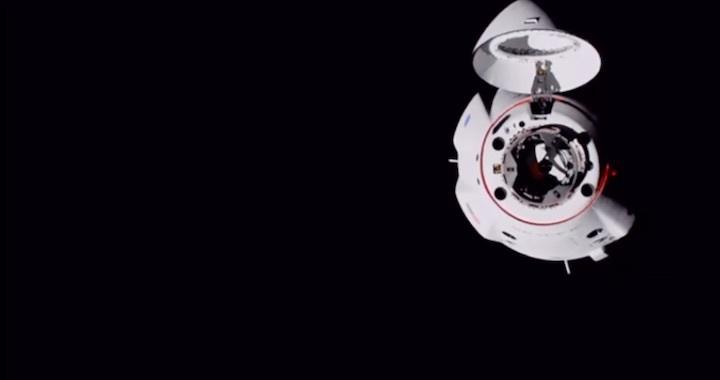






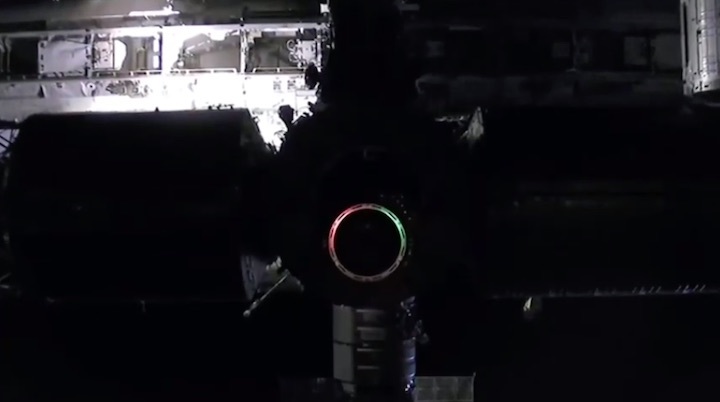

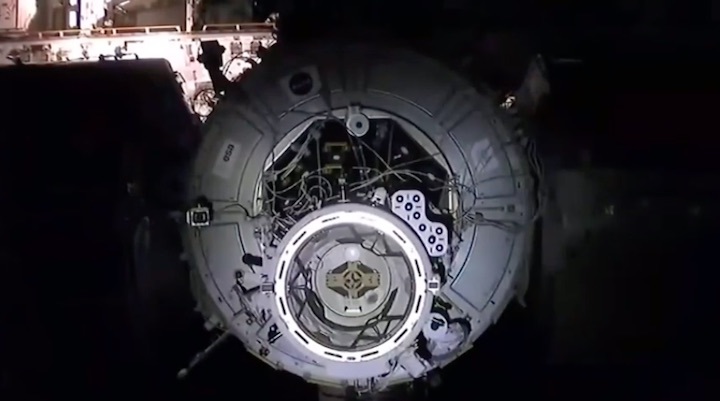
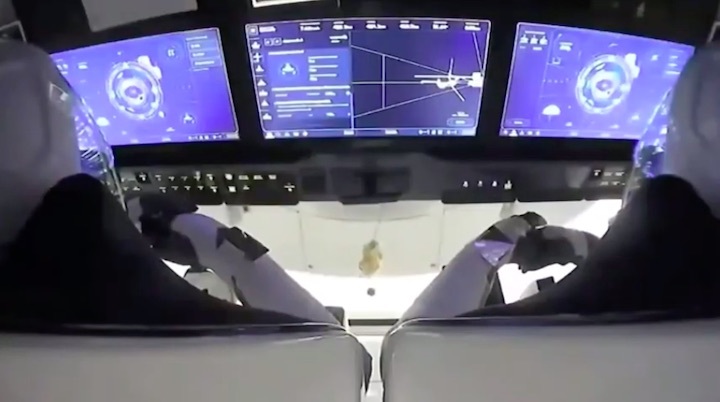
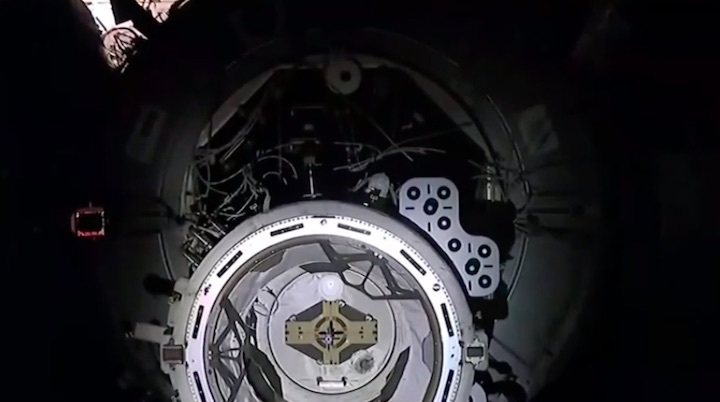
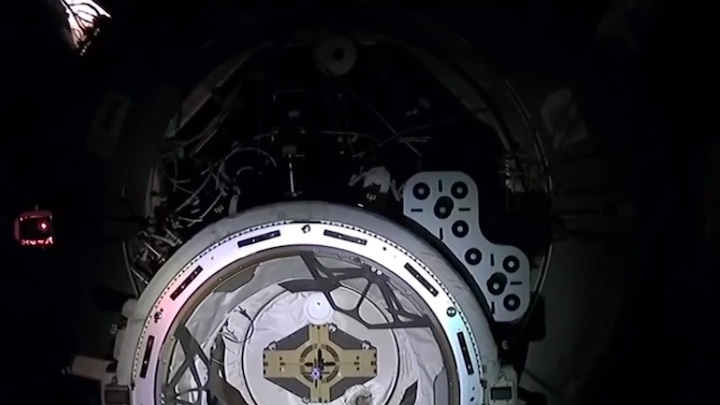
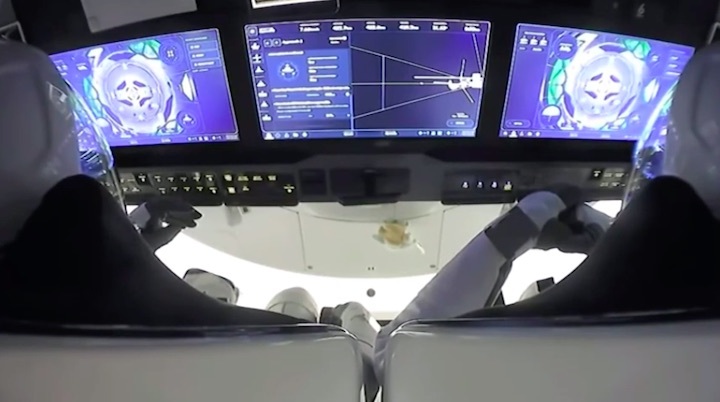




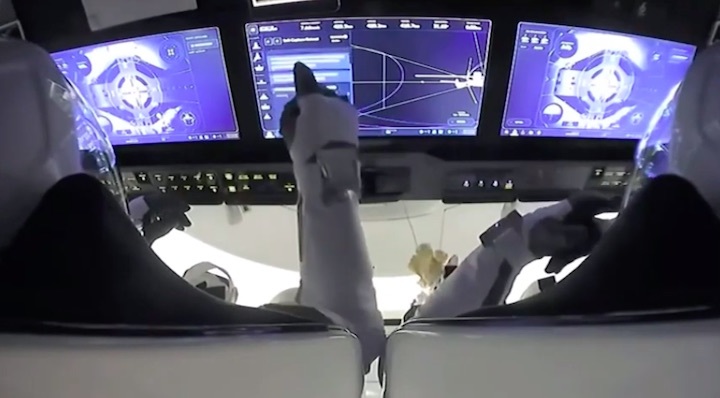

Quelle: NASA-TV
+++



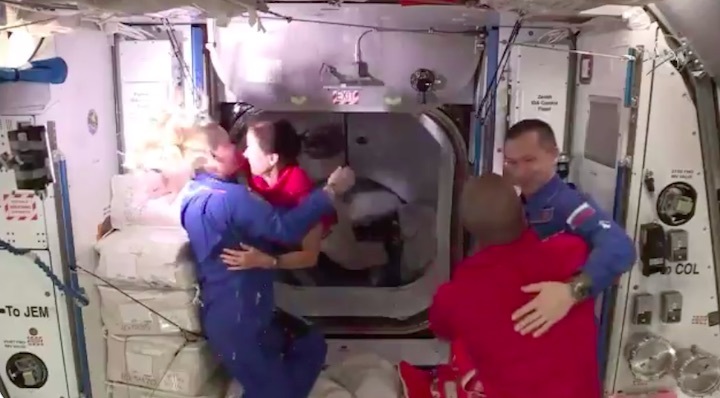



Quelle: NASA-TV
+++
Nasa SpaceX mission: Dragon capsule docks with space station
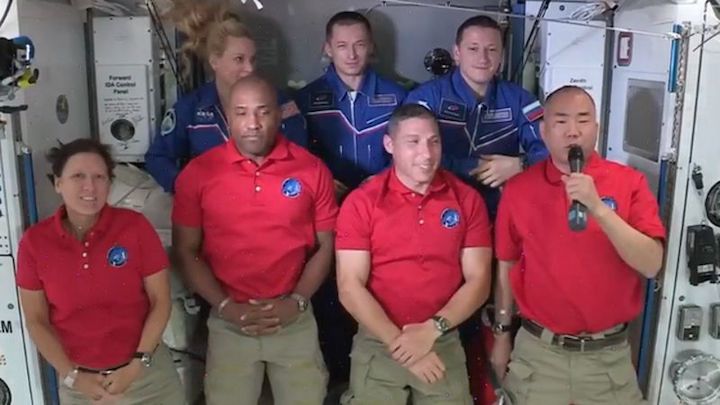
The four astronauts who left Earth on Monday (GMT) have arrived at the International Space Station (ISS).
Their SpaceX Dragon capsule made a series of inch-perfect manoeuvres to bring them into an attachment position on the front of the orbiting lab.
Commander Mike Hopkins, Shannon Walker, Victor Glover and Soichi Noguchi will be spending the next six months aloft.
They join three individuals already aboard - Kate Rubins, Sergey Ryzhikov and Sergey Kud-Sverchkov.
Raising the resident complement to seven individuals will triple the amount of microgravity science that can be conducted on the 410km-high outpost, the US space agency Nasa says.
The Dragon docked at 04:01, just as the station was flying over the US state of Idaho.
The incoming crew had to wait for seal and pressure checks before the hatches between the Dragon and the ISS could be opened. But once this was completed, they were able to enter their new home.
Mike Hopkins said his team had had an amazing ride up from Earth.
"I can't tell you how excited we were when that rocket lifted off the pad, and then the last 27 hours have gone really smooth," he radioed down to Earth.
"We are so excited to be here. We are humbled and we are excited to be a part of this great expedition. And we are looking forward to the next six months and can't wait to get started."
The capsule commander and his colleagues are the first crew rotation to be brought up to the station on a fully certified, commercial human transportation system, hence their tagline - Crew-1.
The Falcon rocket and Dragon capsule they used to get off Earth is a service the Californian firm SpaceX now sells to Nasa. And the agency has a contract with the company for a further five crew rotations after this one.
It's a new way of doing business for Nasa, who always used to own and operate the hardware needed to get astronauts into low-Earth orbit.
Now that the agency can source taxi rides from a private supplier, it is focussing its efforts on developing a rocket and capsule for the more challenging task of taking people back to the Moon, something it hopes to do later this decade.
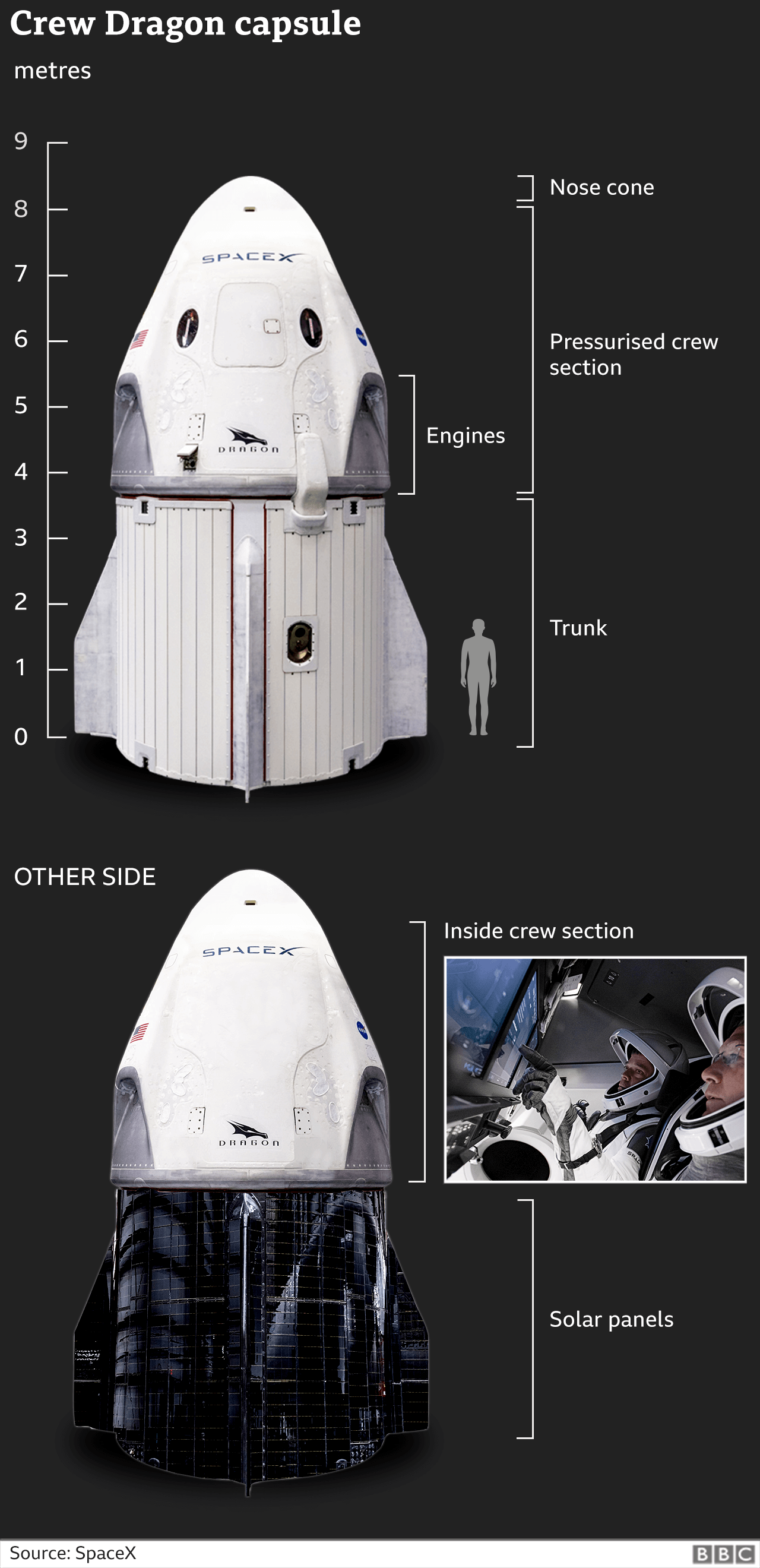

Hopkins' team has a full programme of research ahead of it. An example experiment involves chips with tissue that mimics the structure and function of human organs, to try to understand the role of microgravity on human health and disease.
The crew will go on at least four spacewalks outside the station.
One of these activities is expected to result in the installation of the first significant UK industrial contribution to the platform.
This is the ColKa communications terminal. Made by MDA UK, the radio equipment will enable astronauts to connect with scientists and family on Earth at home broadband speeds. ColKa will be fixed to the exterior of the European Space Agency's ISS research module, Columbus.
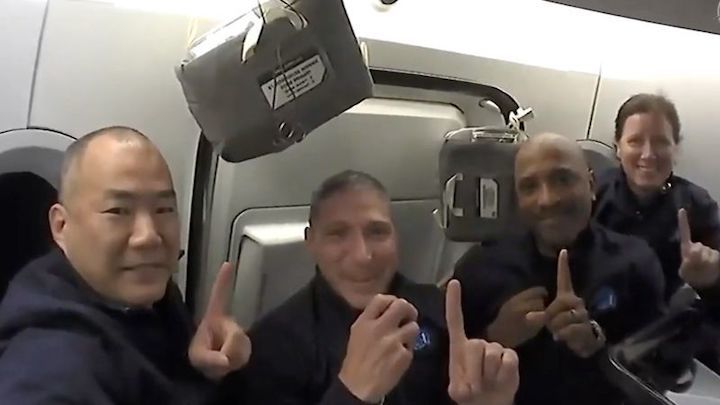

The baby Yoda toy indicates to the crew they are in weightless conditions
The crew will also see a wide variety of space vehicles come and go during their time aboard.
Among these vehicles should be the Boeing aerospace corporation's Starliner capsule.
Like the SpaceX Dragon ship, Starliner is being offered to Nasa and its partner agencies on a commercial basis to ferry astronauts to and from the ISS.
"Low-Earth orbit for over 50 years was the domain of governments. Now, we've seen commercial companies, SpaceX being the first, take astronauts to the space station, with Boeing set to follow, hopefully sometime next year," commented former Nasa astronaut Leroy Chiao.
"It very much follows the aviation era where airliners used to be government run, and now of course they've been commercial for a number of decades," the shuttle and Soyuz flier told BBC News.
Quelle: BBC
----
Update: 30.03.2021
.
Japan astronaut Noguchi to return to Earth on April 28 aboard SpaceX ship
Japanese astronaut Soichi Noguchi and three U.S. astronauts who traveled to the International Space Station aboard the commercially developed SpaceX Crew Dragon ship will return to Earth on April 28, NASA said Monday.
The four members of the Crew-1 mission, also including Michael Hopkins, Victor Glover and Shannon Walker, have been staying on the ISS since November, following the space ship's successful second manned flight to the orbiting laboratory. It was also the ship's first journey with a Japanese astronaut.

Another Crew Dragon capsule is scheduled to launch to the ISS no earlier than April 22 with the Crew-2 mission -- Japan's Akihiko Hoshide along with two astronauts from NASA and one from the European Space Agency.
This will mean there will be several days when two Japanese astronauts will be present in the ISS at the same time. Such a situation has not happened since 2010 when astronaut Naoko Yamazaki joined Noguchi at the ISS.

About five days after the Crew-2 arrival at the ISS, Crew-1 plans to splash down off the coast of Florida, according to the National Aeronautics and Space Administration.
Crew Dragon, developed by Space Exploration Technologies Corp., founded by tech billionaire Elon Musk, is NASA's first-ever certified commercial human spacecraft system.
Quelle: Kyodo News
